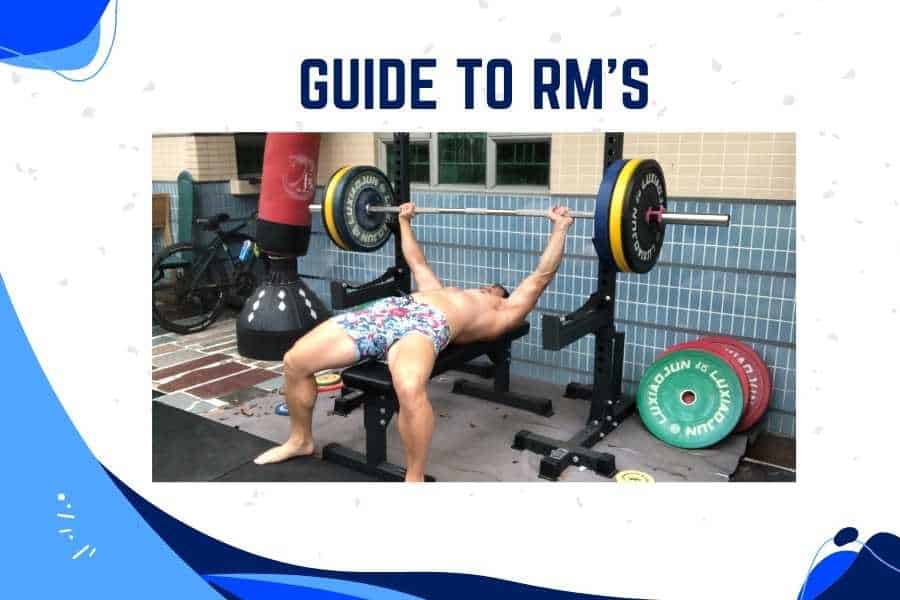“Repetition maximum”, “rep max”, and “RM”- you’ll often hear these phrases in the fitness world. But what exactly does it mean?
A repetition maximum, or “rep-max”, refers to the maximum weight a person can lift in a given rep range for a specified exercise. It’s a measure of the maximum force someone can generate and it can be used to determine the amount of weight to be used in a workout.
When I first started weight training over 5 years ago, I saw this term banded all around the strength training, bodybuilding, and powerlifting programs I was researching.
This article explains what an RM is, how to calculate it, and how to apply it to your training.

- What Is A Repetition Maximum?
- The Rep Max Calculator And How To Use It
- The Repetition Max Continuum
- 1-Repetition Maximum Explained
- 2- And 3-Repetition Maximum Explained
- 4-, 5-, 6-Repetition Maximum Explained
- 7-, 8-, 9-, 10-, 11-, 12-Repetition Maximum Explained
- 13-, 14-, 15-Repetition Maximum Explained
- Why Is Repetition Maximum Important?
- 5 Ways To Increase Your 1-Rep Max
- Conclusion
What Is A Repetition Maximum?
Here’s how the National Academy of Sports Medicine (NASM) defines a rep max:
“Your rep max is the maximum weight you can lift for a given repetition for a given exercise.”
NASM.
Therefore your 1 repetition maximum (1RM) is the heaviest you can lift for 1 rep, a 2 repetition maximum (2RM) is the heaviest you can lift for 2 consecutive reps, and so on.
The Rep Max Calculator And How To Use It
Your 1RM is a useful number to have.
It allows you to calculate an approximate weight to lift in a given rep range. Additionally, different rep ranges are suitable for different training goals.
Here’s to calculate your recommended weight using your 1RM, and the training goal it serves in weight training:
| Reps | % Of 1RM | How To Calculate | Ideal Training Goal |
|---|---|---|---|
| 1RM | 100% | 1RM x 1.00 | Test maximum strength |
| 2RM | 95% | 1RM x 0.95 | Power |
| 3RM | 90% | 1RM x 0.90 | Power |
| 4RM | 88% | 1RM x 0.88 | Power-strength |
| 5RM | 86% | 1RM x 0.86 | Strength |
| 6RM | 84% | 1RM x 0.84 | Strength |
| 7RM | 82% | 1RM x 0.82 | Strength-hypertrophy |
| 8RM | 80% | 1RM x 0.80 | Strength-hypertrophy |
| 9RM | 78% | 1RM x 0.78 | Strength-hypertrophy |
| 10RM | 75% | 1RM x 0.75 | Strength-hypertrophy |
| 11RM | 70% | 1RM x 0.70 | Strength-hypertrophy |
| 12RM | 65% | 1RM x 0.65 | Strength-hypertrophy |
| 13RM | 60% | 1RM x 0.60 | Hypertrophy |
| 14RM | 55% | 1RM x 0.55 | Hypertrophy |
| 15RM | 50% | 1RM x 0.50 | Hypertrophy |
| 16RM+ | 45+ | 1RM x0.45+ | Endurance |
For the sake of simplicity, each rep range has been designated a specific training goal. But in reality, the effects of each rep range lie on a continuum.
For example, training with 5 reps is great for emphasizing strength, but it also leads to hypertrophy. Likewise, training with 15 reps mainly emphasizes hypertrophy, but it also leads to strength gains too.
Thus, different rep ranges result in different training benefits to different degrees (see next).
The Repetition Max Continuum
The repetition max continuum is a model to describe how repetition and weight load affect training goal optimization. The model states that different rep numbers and training loads lead to varying degrees of muscle power, strength, and hypertrophy gains.
Here’s the full repetition max continuum and how it affects training results:
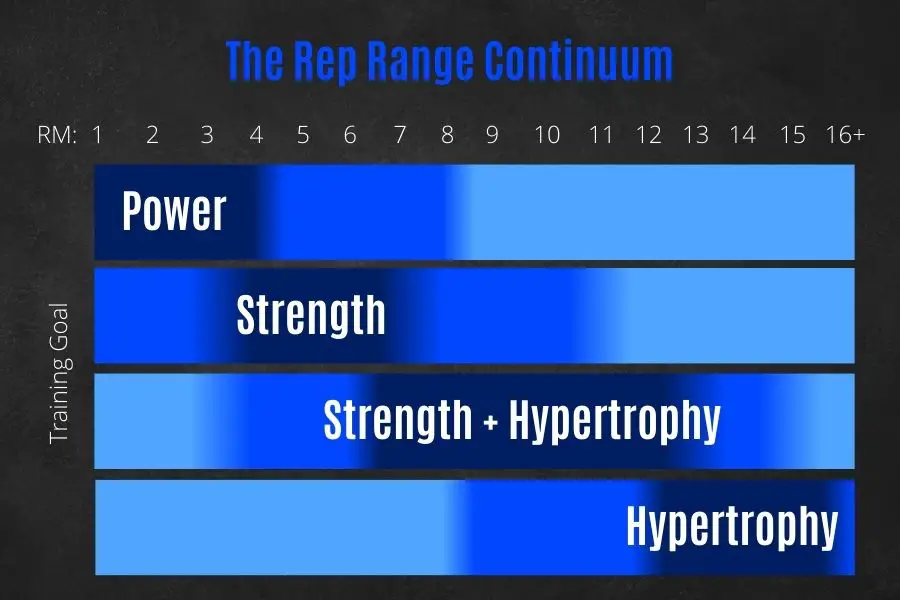
Now you can see for example- whilst a 2RM mainly emphasizes power gains, it also leads to a degree of hypertrophy (muscle growth) as well.
Similarly, a 15RM is great for optimizing hypertrophy, but it will also lead to a degree of strength gains too.
So the question becomes:
“Which training goal do you wish to optimize?”
Once you’ve decided on a specific goal to optimize, you can choose the RM you wish to train in and then calculate how much weight you should be lifting for that RM (using the table given in the previous section).
1-Repetition Maximum Explained
A 1-rep max is used to measure maximal power generation for a given exercise. It can be determined by lifting 60-80% of the estimated 1RM, resting for 3-5 minutes, and progressively adding weight after each rest until failure. It can also be estimated with a strength database.
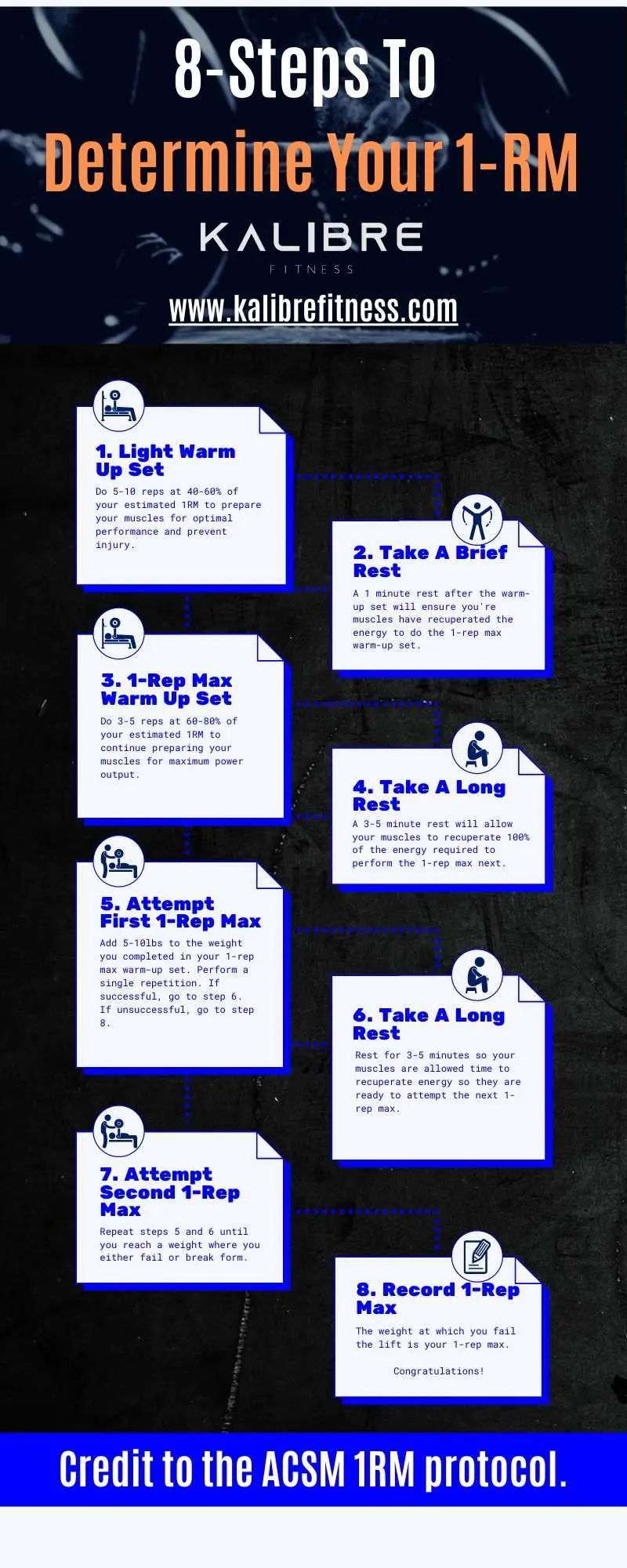
Detailed 1RM protocol.
Your 1-rep max is fundamental to calculating your other RMs.
This makes it important to determine you’re 1RM as accurately as possible.
Here’s the American College of Sports Medicine (ACSM) protocol for calculating 1RM:
- Warm-up by doing 5-10 reps at 40-60% of the estimated 1RM.
- Rest for 1 minute whilst performing static stretches.
- Perform 3-5 reps at 60-80% of the estimated 1RM.
- Rest for 3-5 minutes.
- Add 5-10lbs and perform a single repetition. If successful, continue to steps 6. and 7.
- Rest for 3-5 minutes and perform another single repetition.
- Continue resting and adding weight until failure.
- Record the weight of the failed attempt (1RM).
Ideally, you should reach you’re 1RM within 5 attempts. This will reduce the likelihood of fatigue affecting your 1RM.
It’s also important to have a spotter on standby to assist with any failed attempts.
How to estimate your 1RM.
If you don’t have a spotter available, the safest alternative to actually measuring your 1RM is to estimate it instead.
This can be done by determining you’re current body weight and training level (novice, beginner, intermediate, advanced, or elite).
Now you can go on the Strength Level Database, locate the desired exercise, and it will give you an estimated 1RM based on thousands of user-generated lifts.
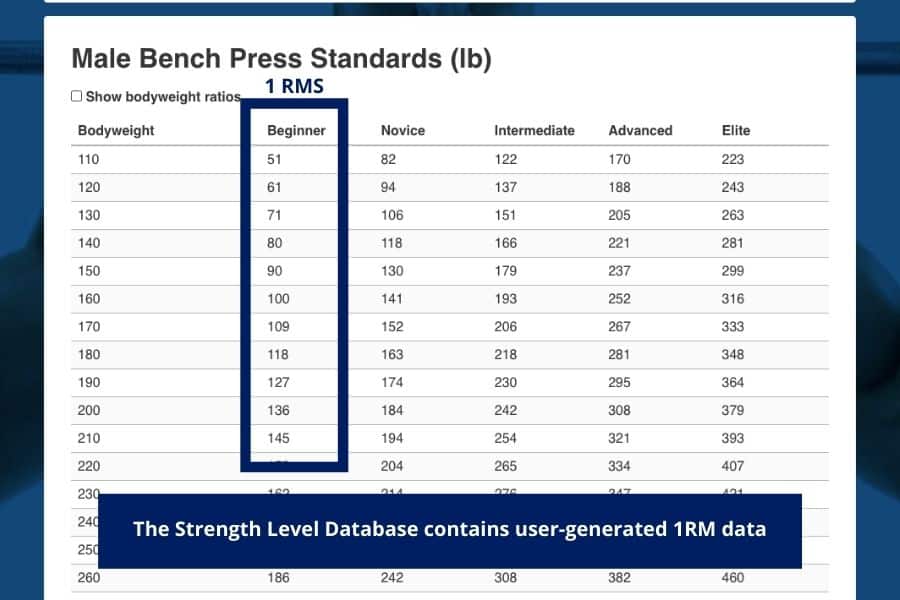
This method isn’t as accurate as the ACMS 1RM protocol, but it’s much safer for beginners and people who are training solo.
Typical 1RM for beginners.
Assuming the average male weighs 200lbs and the average female weighs 170lbs, here are the typical beginner 1RMs for the 5 main barbell lifts:
| Compound Exercise | Average Male Beginner 1RM | Average Female Beginner 1RM |
|---|---|---|
| Bench press | 135lb / 60kg | 50lb / 25kg |
| Shoulder press | 85lb / 40kg | 35lb / 15kg |
| Bent-over row | 115lb / 55kg | 40lb / 20kg |
| Squat | 185lb / 85kg | 85lb / 40kg |
| Deadlift | 220lb / 100kg | 105lb / 50kg |
These numbers are based on the Strength Level database. A beginner is someone who has been practicing the exercise for at least 1 month.
2- And 3-Repetition Maximum Explained
Lifting in the 2- and 3-rep range is used to emphasize power gains for a given weight training exercise. It’s defined as 95% to 90% of the 1-rep max and can be calculated by multiplying the 1RM by 0.95 or 0.90, respectively.
Muscular power refers to your ability to produce maximal force over the shortest period of time. Examples of power include powerlifting movements, explosive jumping, and punching.

How to calculate 2- and 3-RM:
- Determine or estimate the 1-rep max. See the previous section for “1-RM protocol”.
- Multiply 1-RM by 0.95 for a 2-RM.
- Multiply 1-RM by 0.90 for a 3-RM.
4-, 5-, 6-Repetition Maximum Explained
Lifting in the 4-, 5- and 6-rep range is used to emphasize strength gains for a given weight training exercise. It’s defined as 88%, 86%, or 84% of the 1-rep max and can be calculated by multiplying the 1-rep max by 0.88, 0.86, or 0.84, respectively.
Muscular strength is defined as the ability to overcome resistance. In other words, how much weight you can lift.
It’s similar to power but differs slightly because- unlike power- strength does not take into account how quickly the force is overcome.
Strength examples include lifting heavy weights for multiple reps, uphill cycling, and pushing/pulling against an opposing force.

How to calculate 4-, 5-, and 6-RM:
- Determine or estimate the 1-rep max. See the previous section for “1-RM protocol”.
- Multiply 1-RM by 0.88 for a 4-RM.
- Multiply 1-RM by 0.86 for a 5-RM.
- Multiply 1-RM by 0.84 for a 6-RM.
7-, 8-, 9-, 10-, 11-, 12-Repetition Maximum Explained
Lifting in the 7-, 8-, 9-, 10-, 11- and 12-rep ranges are used to emphasize strength and hypertrophy. It’s defined as 82%, 80%, 78%, 75%, 70% or 65% of the 1RM and can be calculated by multiplying the 1RM by 0.82, 0.80, 0.78, 0.75, 0.70, or 0.65, respectively.
Muscular hypertrophy describes the process of increasing muscle size.
Since this rep range strikes a good balance between strength and hypertrophy, you’ll also find this to be the most popular rep range in the majority of general weight training programs.

How to calculate 7-, 8-, 9-, 10-, 11-, and 12-RM:
- Determine or estimate the 1-rep max. See previous section for “1-RM protocol”.
- Multiply 1-RM by 0.82 for a 7-RM.
- Multiply 1-RM by 0.80 for a 8-RM.
- Multiply 1-RM by 0.78 for a 9-RM.
- Multiply 1-RM by 0.75 for a 10-RM.
- Multiply 1-RM by 0.70 for a 11-RM.
- Multiply 1-RM by 0.65 for a 12-RM.
13-, 14-, 15-Repetition Maximum Explained
Lifting in the 13-, 14- and 15-rep ranges is used to emphasize muscle hypertrophy. It’s defined as 60%, 55%, or 50% of the 1-rep max and can be calculated by multiplying the 1-rep max by 0.60, 0.55, or 0.50, respectively.
Smaller isolation-type movements such as bicep curls and tricep extensions are commonly performed using this moderately-high rep range.
But compound lifts like the bench press, squat, etc can also be effective for high-volume reps if an appropriate weight is used.
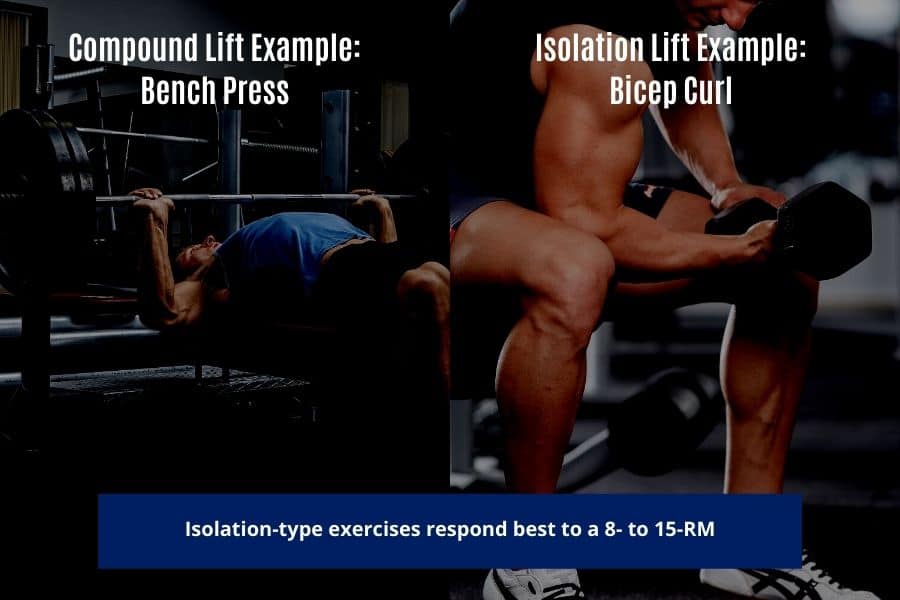
How to calculate 13-, 14, and 15-RM:
- Determine or estimate the 1-rep max. See previous section for “1-RM protocol”.
- Multiply 1-RM by 0.60 for a 13-RM.
- Multiply 1-RM by 0.55 for a 14-RM.
- Multiply 1-RM by 0.50 for a 15-RM.
Why Is Repetition Maximum Important?
There are two important reasons to determine a repetition maximum. Firstly, it allows a person to gauge their strength. Secondly, most training programs give weight recommendations as a percentage of repetition.
Here are the two reasons in more detail:
1. Gauging relative strength.
Personal trainers and coaches often test their client’s 1-rep max as standard protocol.
This allows the trainer to objectively determine how strong someone is. And this in turn decides how much weight the client should lift to accomplish a specific training goal safely.
Whether the goal is to build muscle, increase strength, burn fat, tone, or a combination of goals, the 1-rep max is the first step in deciding how much weight to lift for working reps.
2. Standardising weight training programs.
Different people have different strength levels and this needs to be accounted for in a weight training program.
For example, it wouldn’t make sense to recommend every to bench press 200lbs. Beginners would find this impossible to lift. Whereas a trained powerlifter would have no problem with this weight.
Therefore it’s important for weight training programs to be standardized, allowing for people of all strength levels to use the program.
This is why exercise instructions often recommend weights as a “% of 1RM”. This simply means lifting a weight that is x-percent of your 1-rep max.
For example: 80% of a 100lb 1RM = 80lbs.
Other programs may recommend weights as x-RM. For example, 5RM, 6RM, and so on. This simply means using a weight you can lift for the specified RM.
For example: if you can just about lift 80lbs for 8 reps, then you’re 8RM is 80lbs.
5 Ways To Increase Your 1-Rep Max
If you’re RM is plateauing, you can apply techniques to break the plateau and continue getting bigger and stronger.
Here are 5 tips I used to increase my repetition maximum:
1) Progressive overload regularly.
This is the first and most obvious way to increase your 1-rep max. Progressive overload requires you to add weight to your lifts every 1 or 2 weeks.
Many people follow the 5/10% rule- add 5% weight to your upper-body lifts and 10% to your lower-body lifts.
This worked well for me.
But there might come a point where a 5/10% increase begins to become too much (when your form breaks down and you simply can’t lift the extra weight).
At this stage, you can try the 1% rule:
“Increase your 1RM by 1% for each rep you complete over the prescribed rep range for your current lift.”
Giovani Grassi, C.S.C.S Strength Coach
For example: if your bench press 8RM is 100lbs, and you can now do 9 reps, then add 1lb (1% of 100lb is 1lb)
This method allows you to apply progressive overload more frequently, albeit to a lesser degree.
2) Consume bulking calories every day.
Skinny beginners can usually gain strength easily due to the honeymoon period of training known as “Newbie Gainz”.
But for the most efficient strength and muscle gains, it’s important to consume a protein-rich bulking diet.
To do this, you should eat in a calorie surplus. A daily 5-10% surplus is generally recommended.
Additionally, you should be eating enough protein.
“Aim for 0.8-1.0 grams of protein per pound of body weight everyday during your bulk. Any less could result in decreased muscle growth and recovery.”
Mike Dewar, C.S.C.S Strength Coach
Eating sufficient calories and protein can help you get stronger and increase your 1-rep max.
3) Vary your rep ranges.
As a skinny guy, you’re generally recommended to lift heavy for low reps to maximize muscle gains.
But remember how different rep ranges lead to different training results, and how this occurs on a continuum?
Well, a great way to capitalize on all the benefits within the spectrum is to vary your rep ranges.
I do this, for example, by alternating between the 3-6 rep zone for 1 month and the 8-12 rep zone for the next month.
Why is this effective for increasing your 1-rep max?
By varying your rep ranges, you reap the benefits from 3 different muscle-building stimuli; 1) metabolic stress (from lifting high rep ranges), 2) time under tension (again from lifting high reps), and 3) mechanical tension (from lifting low reps).
This technique is called periodization- the idea is to keep challenging your muscle with both strength and hypertrophy rep ranges for all-around muscle gains.
4) Use bands to increase difficulty.
Heavy lifting is generally recommended for anyone who is looking to gain muscle and strength. Resistance bands allow you to take things further by varying the strength curve in your lifts.
When used properly- the exercise becomes harder as the band stretches. And this training technique can help you to increase your RM.
It’s common for powerlifters to loop a band around a barbell. The movement remains the same, but the increased tension from the bands now makes the exercise harder towards the top.
Terry Ramos, Personal Trainer, Barbend

I found this method to be great for breaking strength plateaus.
5) Control you’re breathing.
If you’re breathing is out of sync with your lift, you may find your 1-rep max to be negatively impacted.
“You never want to exhale during the 1RM. Take a deep breath and hold it as you descend and ascend.”
Bodybuilding
Inhaling on the descent phase of lighter lifts (8-12RM) is fine and recommended.
But during the heavier lifts (1-7RM), it helps to hold your breath during the ascent phase.
Conclusion
I’ve shared a guide to what a repetition maximum is and how to use it.
A 1-rep max (RM) is a measure of absolute strength for a single repetition. It can be determined using the 1RM protocol or estimated using a database.
1RM plays a vital role in structuring your workout program. It allows you to calculate weights to be used for working rep ranges.
You may also be interested in the downloadable Kalibre Blueprint PDF which details exactly how I gained 40lbs of lean muscle (it’s 100% free!). It details the exact exercises and nutrition (with printables) I used to go from skinny to ripped!

